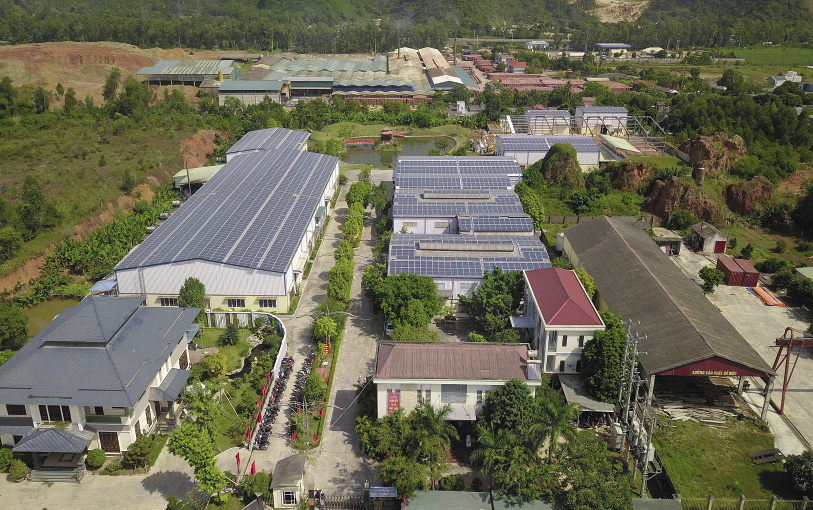Thanks to a generous solar feed-in tariff (FIT) Vietnam’s PV market went from a mere 100 MW at the end of 2018, to around 5.7 GW at the end of last year. In his presentation during the Jinko webinar, held on October 14, 2020, Tuan A. Nguyen provided an update on the numbers. As of June this year, 5,678 MW of ground-mounted PV were in operation, in addition to 47.5 MW of floating PV and 800 MW of RTS systems. The latter category involves systems below 1 MW of capacity, which are not required to go through the approval process required of larger plants.
On the utility side of the market, the fact the development pipeline involves 25,342 MW of projects as of June this year is a very encouraging sign that utility scale projects continue to be developed at a rapid pace, even though the FIT era in Vietnam will probably end this December – at least in the large scale ground-mounted segment.
According to Mr. Tuan, the current FIT rates in the non-RTS markets will instead function as price ceilings in competitive auctions. China went through a similar transformation, turning a straightforward national solar FIT regime into a competitive auction process, in which the established FIT rates functioned solely as a price ceiling on auctions. Next year should mark the beginning of a similar auction process in Vietnam, while the regular FIT mechanism should remain a while longer in the RTS market segment.
Mr. Tuan also provided figures for this August, showing that the RTS market continues to grow at a healthy pace. At the end of August, a cumulative number of 48,631 RTS systems had been installed in Vietnam with a cumulative capacity of 1,168.1 MWp. At the beginning of this year, this cumulative figure was still below the 600 MW threshold, showing remarkable growth for this nascent segment. At the end of August, 567.68 MWp had been installed in the southern region of Vietnam, eclipsing the central region of the country with 390.91 MWp.
These are the leading regions for both utility scale and RTS systems in the country, mainly because of the high irradiation levels compared to northern Vietnam (900-1,100 kWh/kWp in the North compared to 1,400-1,600 kWh/kWp in the South).
As Mr. Tuan further revealed, 85% of the RTS systems installed in Vietnam by the end of August involved residential systems, with commercial (3,110) and industrial (3,211) systems being far smaller in number. (The smallest category is RTS systems on administrative offices. These constituted just 750 in the August total.)
The new GIZ publication is well timed, since with the Prime Minister’s Decision 13/2020, which came into effect this April, Vietnam’s legal framework now recognizes so-called Private PPAs between a system owner and a private offtaker. In the C&I space, this will typically involve a Solar Service Company (SSC) owning the RTS system and the Facility Owner (FO), who will procure the PV electricity for his commercial or industrial operation.
The new GIZ Guidelines provide useful templates for the necessary contracts and the GIZ Guidelines distinguish between the Third-Party Ownership Model (TOM) – relevant for Private PPAs – and the Self-Ownership Model (SOM), which has so far been the driving force behind C&I installations in Vietnam (usually by way of a solar lease, whereby the FO leases the RTS system from the SSC, thereby making the FO the effective RTS system owner under relevant Vietnamese law).
Whether the model adopted is TOM or SOM, in both cases at least a portion of the generated electricity can be sold via a PPA with the state utility EVN, and the GIZ Guidelines provide detailed information also on this part of the equation.
Currently, the FIT applicable to RTS systems amounts to VND 1,943 per kWh or USD 8.38 cents. According to the GIZ Guidelines, “This FIT level applies and is guaranteed for RTS systems that are installed and connected to the grid before 31 December 2020 and has a validity of up to 20 years thereafter, depending on the duration of the Power Purchase Agreement (PPA) signed between the project owner and the power company, EVN.”
With utility scale solar in Vietnam entering a new era next year, the diversification of the country’s solar PV market assumes greater importance to provide a bigger range of markets for PV to contribute a growing share of the country’s electricity demand, which is increasing at an annual rate of 6-9% until 2030.
In the Jinko webinar last week Mr. Tuan pointed to the growing share of PV in the country’s Power Development Plan (PDP), from just 12 GW by 2030 in the revised PDP 7 issued in March 2016 to as much as 21 GW by 2030 in PDP 8, which is expected to be approved early next year.
This content is protected by copyright and may not be reused. If you want to cooperate with us and would like to reuse some of our content, please contact: editors@pv-magazine.com.



By submitting this form you agree to pv magazine using your data for the purposes of publishing your comment.
Your personal data will only be disclosed or otherwise transmitted to third parties for the purposes of spam filtering or if this is necessary for technical maintenance of the website. Any other transfer to third parties will not take place unless this is justified on the basis of applicable data protection regulations or if pv magazine is legally obliged to do so.
You may revoke this consent at any time with effect for the future, in which case your personal data will be deleted immediately. Otherwise, your data will be deleted if pv magazine has processed your request or the purpose of data storage is fulfilled.
Further information on data privacy can be found in our Data Protection Policy.